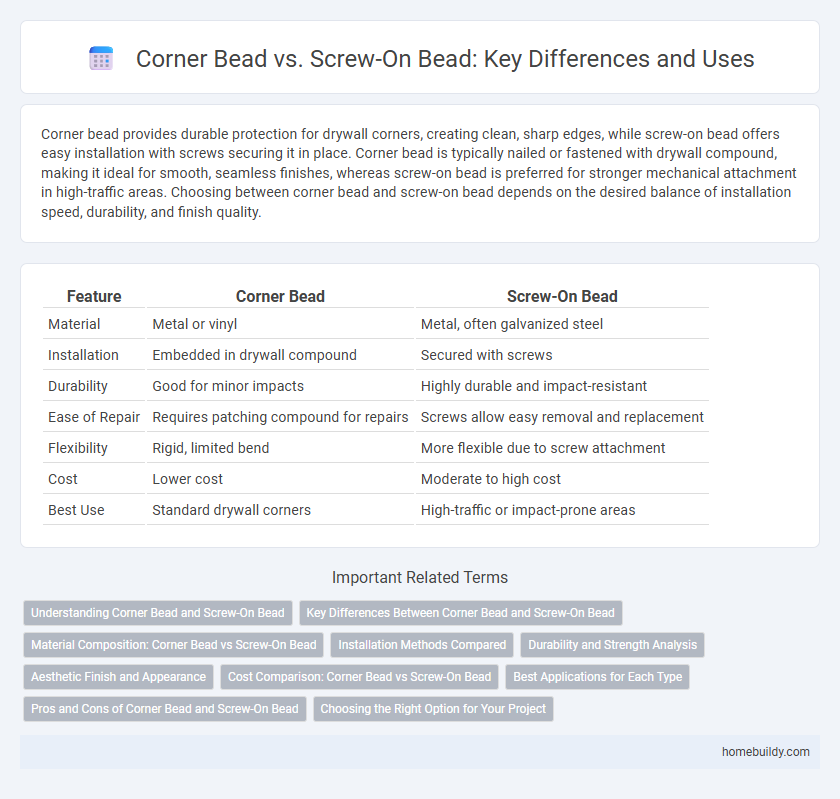Corner bead provides durable protection for drywall corners, creating clean, sharp edges, while screw-on bead offers easy installation with screws securing it in place. Corner bead is typically nailed or fastened with drywall compound, making it ideal for smooth, seamless finishes, whereas screw-on bead is preferred for stronger mechanical attachment in high-traffic areas. Choosing between corner bead and screw-on bead depends on the desired balance of installation speed, durability, and finish quality.
Table of Comparison
| Feature | Corner Bead | Screw-On Bead |
|---|---|---|
| Material | Metal or vinyl | Metal, often galvanized steel |
| Installation | Embedded in drywall compound | Secured with screws |
| Durability | Good for minor impacts | Highly durable and impact-resistant |
| Ease of Repair | Requires patching compound for repairs | Screws allow easy removal and replacement |
| Flexibility | Rigid, limited bend | More flexible due to screw attachment |
| Cost | Lower cost | Moderate to high cost |
| Best Use | Standard drywall corners | High-traffic or impact-prone areas |
Understanding Corner Bead and Screw-On Bead
Corner bead is a drywall accessory designed to reinforce and create clean, straight edges on wall corners, typically made of metal or plastic. Screw-on bead offers similar edge protection but is attached with screws, providing enhanced durability and easier adjustment during installation. Choosing between corner bead and screw-on bead depends on factors like corner thickness, installation speed, and the level of impact resistance required.
Key Differences Between Corner Bead and Screw-On Bead
Corner bead provides a flexible, easy-to-install solution for protecting drywall corners with a simple metal or plastic strip, while screw-on bead features pre-drilled holes that require fastening with screws for enhanced stability. The main differences lie in installation methods, with corner bead typically secured using nails or adhesive and screw-on bead requiring screws for a more durable hold. Material options also vary, as corner beads are commonly made from metal or vinyl, whereas screw-on beads often emphasize metal construction for heavy-duty applications.
Material Composition: Corner Bead vs Screw-On Bead
Corner bead is typically made from galvanized steel or vinyl, providing durability and rust resistance for drywall corners. Screw-on bead, often constructed from metal or plastic with pre-attached screw flanges, offers enhanced stability and easy installation by securing directly to wall studs. Both materials impact flexibility, corrosion resistance, and suitability for specific drywall applications.
Installation Methods Compared
Corner bead installation involves embedding metal or vinyl strips into drywall corners using drywall compound for a smooth, reinforced finish, while screw-on beads require fastening with screws, offering a more mechanical and durable attachment. The embedded method allows for seamless blending with drywall surfaces, ideal for painter-ready walls, whereas screw-on beads provide enhanced stability and strength, particularly suited for high-traffic areas prone to impact. Choosing between the two depends on the desired balance between ease of finishing and structural robustness in drywall corner protection.
Durability and Strength Analysis
Corner bead offers superior durability due to its reinforced metal or vinyl construction that resists dents and warping over time, ensuring long-lasting protection for drywall corners. Screw-on bead, while easier to install, may compromise strength as the screws can loosen or cause localized weaknesses, reducing overall impact resistance. For applications requiring maximum structural integrity and prolonged corner reinforcement, corner bead remains the preferred choice in construction.
Aesthetic Finish and Appearance
Corner bead offers a smoother, more seamless aesthetic finish compared to screw-on bead, which can sometimes show visible screw heads disrupting the surface uniformity. The continuous profile of corner bead ensures clean, sharp edges, enhancing the overall appearance of drywall corners. In contrast, screw-on bead may require additional finishing work to conceal fasteners and achieve a polished look.
Cost Comparison: Corner Bead vs Screw-On Bead
Corner bead typically costs less than screw-on bead due to its simpler installation process and fewer required materials. Screw-on bead involves additional hardware expenses and labor time, making it more expensive overall. For budget-conscious projects, corner bead offers a cost-effective solution without compromising edge protection quality.
Best Applications for Each Type
Corner bead, typically made from metal or vinyl, is ideal for drywall corners requiring smooth, durable finishes especially in high-traffic areas like commercial spaces. Screw-on bead features pre-installed screws or fasteners, providing enhanced stability and is best suited for heavy-duty applications where greater structural reinforcement is needed, such as in industrial or exterior drywall installations. Choosing the right bead depends on factors like wall material, expected wear, and installation environment to ensure optimal performance and longevity.
Pros and Cons of Corner Bead and Screw-On Bead
Corner bead provides a seamless, smooth finish ideal for drywall corners, offering durability and easy paintability but may crack under heavy impact. Screw-on bead secures with fasteners, ensuring a strong hold on uneven surfaces and heavy usage areas but requires more installation time and may show visible screw heads. Choosing between corner bead and screw-on bead depends on the balance of aesthetic finish versus structural strength needs.
Choosing the Right Option for Your Project
Corner bead offers a seamless finish ideal for high-traffic areas, providing durability and easy installation with metal or vinyl materials. Screw-on bead is perfect for projects requiring extra strength and adjustability, secured with screws to prevent movement and enhance stability. Selecting the right option depends on the project's structural needs, surface type, and desired finish quality.
corner bead vs screw-on bead Infographic

 homebuildy.com
homebuildy.com